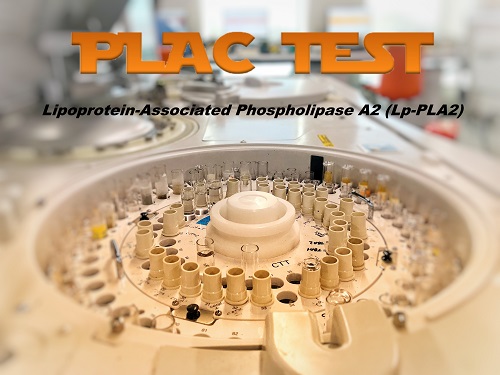
Services
Menu
Drug Levels
Microbiology
Clinical Biochemistry
Congenital Metabolic Disorders
Haematology Laboratory
Prenatal Screening Tests
Molecular Microbiology
Allergies
Transfusion Centers
LabBlog!




Clinical Biochemistry
- Screening of the general population
- Clinical categorisation of the cancer
- Prognostic monitoring of the advance of the condition
- Evaluation of success in treatment
- Determining a recurrence of the cancer
Principal among these:
Prostate Specific Antigen, or PSA: a very beneficial indicator in diagnosing prostatecancer; it is used in its prostate cancer diagnosis, staging and treatment. The most beneficial clinical advantage is its use in the monitoring of prostate cancer treatment.
Calcitonin: used in the diagnosis of thyroid medullary cancer.
Chorionoc gonodotropin (hCG): Is a very useful indicator which is used in the diagnosis of trophoblastic tumors and non-seminomatose testicular carcinoma. Shows an increases in nearly all rophoblastic tumors and an increase of 70% in non-seminomatose testicular cancer. Is beneficial in the tracking of trophoblastic disease advance as well as tracking of treatment.
Alpha fetoprotein (AFP): used in the diagnosis, identification of prognosis and tracking of treatment in hepatocellular carcinoma, and along with hCG it is used in the staging of germ celled tumors. It has provided successful results in high risk haepatocellular carcinoma regions as well as in screenings for high risk groups.
Carcino embryonic antigen (CEA): is an indicator for colorectal and gastrointestinal system and pancreas cancers. It may show an increase with conditions such as cirrhosis, ulcerative colitis and benign breast diseases and is used in the staging of colon cancer.
CA 15-3: is used in the staging of patients with metastatic breast cancers.
CA 125: is an indicator used in patients with ovarian or endometrial cancers.
CA 19-9: is an indicator for pancreatic and colorectal cancers; at the same time it will exhibit an increase with acute and chronic pancreatitis and cholangitis.
CA 72-4: an indicator for gastrointestinal carcinomas.NMP 22 (Nuclear Matrix protein): an indicator in transitional celled urinary tract carcinomas.
PLASMA CELL MALIGNITY, MULTIPLE MYELOMA (MM)
Plasma cell diseases are a group of neoplastic diseases characterised by theproliferation of a single clone of plasma cells secreting immunoglobins which are rooted in B cell series of immunocytes.
Classification of plasma cell proliferativdiseases:
- Malignant monoclonal gammopathy’s Multiple Myeloma Waldentstöm macroglobulinemia
- MGUS (Monoclonal gammopathy of undetermined significance)
- Light chaine myeloma
- Heavy chain diseases
- Cryoglobulinemia
- Primary amyloidosis
Criteria in diagnosis of symptomatic multiple myeloma (Dimopoulos M, Kyle R, Fermand PJ, et al. 2011):
Electrophoresis tests are the most significant in identification of M proteins in serum and / or urine. This first step is indicating an abnormal concentration and composition of immunglobuline in serum is the serum protein electrophoresis.Should a suspect condition be evident in the beta or gamma regions during serum protein electrophoresis, identifying an increasing immunoglobulin type is made by immunefixation electrophoresis.An agarous gel (Helena SAS-1 Immunofix)is used for immunelectrophoresis. Serum proteins are separated by electrophoresis in the IFE. Immunoprecipation follows using specific antiserums against IgA, IgM, IgG, kappa and lambda. In the presence of M proteins a precipitin band is formed; it is washed with saline gel and unbonded proteins are separated. It is dyed once again and then dried.M protein is predominantly scanned in IgG, IgA, IgM followed by two light chains of kappa and lambda. Kappa/lambda ratio is 2:1. As a discrepancy in this ratio would indicate M proteins the IFE pattern must be examined more closely.
Capillary Electrophoresis (Immundisplacement)
This is a new and modern procedure being used in the past few years. With benefits such as the analysis of smaller volumes, ease of use and a lower per test cost all offered in a rapid procedure it has a number of advantages which allow for its widepsread use. The electrophoresis appartus is made up of 8 capillary tubes with 50 µm diameter and 300 mm length; two electrolytic buffer cells, a high voltage power source and a detector connected to a data evaluation unit. Monospecific antserums and the patients’ serum are mixed so as to precipitate each of the light and heavy chains while electrophoresis is done in the capillary tubes in the upper portion. In the presence of increases monoclonal structures they are bonded by antisera and precipitated with a reduction of the peak in the final report.This is why it is known as immundisplacement. Our laboratory uses capillary electrophoresis (immundisplacement) to identify proteins. Validation is done by immunfixation electrophoresis.When SPE, or serum protein electrophoresis, serum free chain measurements and serum immunfixation electrophoresis are used in conjunction 99% of paraproteins can be identified.
Free Light Chain Diseases in Urine (Bence Jones Protein)
BJP’s are monoclonal kappa or lambda immunglobulin light chains. They are not attached to the heavier chain portion of the immunglobulin molecule. They are identified by means of antiserums used against free light chains in immunifixation electrophoresis tests in urine. Kappa and lambda light chains, free kappa and free lambda light chains in urine may quantitatively be identified by nephelometric and turbidimetric means allowing for kappa/lambda values to be evaluated.
Hormones have aregulating effect on the body and are required in human growth, development andreproduction.Hormone tests are used in the treatment of tumors of the glands whichsecrete hormones or the diseases which result in these glands producing eitherinsufficient or excessive hormones for secretion. The primary secreting glandsare the hypothalamus, pituitary gland, thyroid, parathyroid glands, adrenalglands, the pancreas, the ovaries and the testicular glands.Diagnosis andmonitoring of many illness or diseases such as diabetes, osteoporosis,virilism, hirsutism, sexual function disorders, infertility, growth anddevelopment disorders, hypertension is made through hormone tests. Hormonetests are carried out in our laboratories using electrochemiluminencetechniques and test analysers.
Hormonetests of the Pancreas, Stomach, Intestines and Diabetes
Gastrin is ahormone which regulates acid levels of the stomach. It is produced during thewhole of the digestive process by G cells which are found in the stomach.Rareoccurences of G cell hyperplasia and Zollinger- Edison Syndrome (ZE) can resultin the excess production of gastrins and stomach acids. This may result in pepticulcers, which are difficult to treat. Gastrin values are evaluated in itsdiagnosis.Diabetes is a systemic illness which increases blood glucose levelsresulting from insulin insufficiency, insulin resistance or the occurrence ofboth. It is the result of a lack of hormones secreted by the pancreas.In theabsence of complaints a diabetes screen is generally requested of thosecarrying certain risk factors. In pregnant women and in the presence ofrisk factors, a screening should be made during the first physician’scontrol.The insulin hormone starved hypoglycemia, Type 1 and Type 2, insulinoma(Langerhans islet cell tumor) and insulin resistance is used to evaluatediabetes.During starved insulin or OGTT, per minute insulin values may bemeasured. Additionally, C-peptide tests are used to monitor insulin productionand determine the cause of hypoglycemia.
HOMA IR:
Recently wehave been hearing more about the HOMA IR (Insulin Resistance); a test whichallows us to understand whether the body has a resistance to insulin. It isused to determine the surrounding tissues response to insulin. Factors such asbeing overweight, polycystic ovary syndrome, treatment with medicationscontaining cortizone, an increased waist-line, age and a less active life-stylecan lead to insulin resistance.
ThyroidHormone Tests
The thryoid glandis a two-lobed gland located in front of the trachea; its’ purpose is toproduce and secrete T3 and T4 hormones, otherwise known as thyroid hormones.These hormones are important in growth and development and are needed by thebody’s metabolism. A reduction in hormone levels causes a clinical table knownas hypothyroidy while an increase presents itself as a hyperthyroid. Tests fortotal thyroxine (TT4), total triiodothyronine (TT3), free thyroxin (ST4), freetriiodothyronine (ST3) and the thyrotropin (TSH) hormone (which stimulates thepituitary thyroid) are used to diagnose for these clinical tables.
ParathyroidHormone Tests
Parathyroidglands are small endocrine glands located on the neck and mostly behind thethyroid gland. They assume a role in the development of the body’s calciummetabolism and thereby in bone development. An excess of the parathyroidhormone results in loss of bone density, kidney stones and hypertension. Treatmentis generally through the surgical removal of the enlarged gland orglands. Some patients who are not suitable for surgery or whoseparathyroid levels are considered not too high may be monitored. Tests in thiscase are the parathormon intact PTH and parathormon related peptid test.
These tests arebeneficial in differentiating the diagnosis of hyperparathyroidism. It is alsoused to differentiate it from its’ non-parathyroid forms resulting inhypercalcemia. Another hormone used in monitoring calcium metabolism disordersis calcitonine. Calcitonine is also used to monitor thyroid medullarycarcinomas.
Hormone Testsof the Hypophysis
(PituitaryGland)
The hypophysis,or pituitary gland, is situated inside the skull and rests upon the fossa, orbones, which make up the base of the skull itself. It is comprised of twoparts, the anterior pituitary, or “adenohypophysis” and the posteriorpituitary, or “neurohypophysis”, and is anendocrine gland. The hormonessecretedby the anterior pituitary are ACTH, FSH, LH, TSH, the growth hormoneand prolactin. The posterior pituitary gland secretes an antidiuretic hormone(ADH) and oxytocin.Of these hormone, ACTH regulates production of the stresshormone cortizoas produced by the renal glands, the TSH thyroid hormone and FSHand LH hormones in relation to the reproductivity of females and males. Thegrowth hormone is required for growth and development, ADH regulates thebalance of body fluids, oxytocin the contraction of straight muscles duringbirth and of the process of giving birth itself. These hormones are allperiodically required for proper body balance.
An excess ofthe Growth Hormone resultsin gigantism during childhood and acromegaly in adults. A lack of the growthhormone is the cause of dwarfism. As growth in height will be minimal,shortness will be evident; IGF-1, IGF-BP3 as well as growth hormone stimulationand inhibition tests assist in identifying growth anomalies and the evaluationof hypophysis function.
An excess ofprolactin is the earliestclinical symptom of hypophysis disorder. In women, it is characterised by alack of menstruation and evidence of breast milk, whereas in men it ischaracterised by a loss of libido and infertility. It is generally accompaniedby headaches and the impairment of vision.
While a lackof prolactin has no realclinical significance on those who are not pregnant, its’ most importantsymptom, following pregnancy, is an inability to produce breast milk. Theprolactin test is used in these clinical disorders. It is tested on patientswith clinical incompatability in macroprolactine hyperprolactinemia.
An excess ofTSH (Thyroid StimulatingHormone) increases the intake of iodine by the thyroid tissue and T3, T4synthesis is increased; symptoms can be similar to those seen inthyrotoxicosis. Whereas in a lack of TSH thyroid tissue iodine intake and areduction of T3, T4 secretions; the symptoms seen are as in hypothroidism.
LH(Luteinizing Hormone) andFSH (Folicule Stimulating Hormone) regulates testosterone production, testiculargrowth and sperm development in men. In women, it regulates ovary growth andmenstrual flow. A lack of these hormones results in effects such as decreasedsexual desire and infertility in men.In ACTH, or adrenocorticotropic hormonedeficiency, renal gland secretion of cortisol is reduced, resulting inhypocortisolism. This is exhibitted by severe fatigue and paleness. CushingSyndrome is observed with an excess of cortisol. Patients with symptoms ofCushing Syndrome exhibit obesity, hypertension, menstrual irregularity, lack oflibido, round “moon” face, thinning skin, an ability to bruise easily, muscleweakness, darkening of the skin, fungal infections and slow wound healing.
ACTHStimulation Test: iswidely used to evaluate patients suspected of hypocortisolism, adrenaldeficiency and Addisons Disease. A subnormal response to the ACTHstimulation test is sufficient proof of adrenal deficiency, whilenormalresponses rule out adrenal deficiency. Aside from cortisol evaluation theACTH stimulation test may also be used to check per minute values of 17 alphahydroxyprogesteron DHEA-S levels.
DexamethasoneSuppression Test: This isa screening test used to diagnoseCushing Syndrome. Dexamethasone, anadrenocortical steroid, is orally given to the patient on the night beforecortisol levels are tested. Cortisol levels are measured the following day. Innormal individuals cortisol levels are suppressed whereas with Cushing syndromethis suppression does not occur.Symptoms such as an excessive loss of bodyfluids, excessive intake of water and the frequent need to urinate are signs ofADH, or vasopresine deficiency. With an exagerated feeling of thirst, thesepatients will drink between 5-20 liters of water per day. Should they not drinkthis amount, an excessive increase in blood sodium levels may result inconfusion and coma. In an excess of ADH or vasopresine, an inappropriate ADHSyndrome table may be exhibited. A reduction of blood sodium levels, loss ofappetite, nausea, vomitting, confusion and coma may develop. Treatment isprimarily a limitation of water intake and a gradula replacement of the sodiumlost. In disorders of the ADH hormone, a Water Limitation Test is performed.The patient is administered ADH followed by the measurement of changes in urinedensity, osmolarity and serum osmolarity levels which are then used in thediagnosis of central DiabetesInsipidus.
Adrenal GlandHormone Tests
Adrenal glandsare situated over both kidneys. These glands secrete adrenalin, noradrenalin,cortisol and aldosterone. When adrenalin and noradrenalin are secreted into theflow of blood they will increase heart beat rates and blood pressure as well ashave an effect on other body functions. An excess in the secretion of adrenalinand/or noradrenalin will result in a condition known as pheochromocytoma.Hypertension or high blood pressure is evident in most patients with thiscondition. The condition may be diagnosed by checking adrenalin andnoradrenalin levels in blood and urine.
Clinical signsare exhibited as blood pressure which is permanently high or recurring suddenpeaks. Physical or emotional stresses will generally begin the secretionprocess. Aldosterone also plays a role in the body’s salt and fluid metabolismand therefore assumes an important role in the diagnosis and monitoring ofhypertension.
It is thoughtthat mineralocorticoid hypertension constitutes 10% of essential hypertension.Evaluation of hypertension is made on the basis of plasma renin and aldosteronelevels and plasma renin activity, or PRA. An excess of cortisol secretion bythe adrenal glands results inthe Cushingh Syndrome whose diagnosiscan be madeby tests for saliva cortisol, free urine cortisol and dexamethasonesuppression.
AddisonsDisease is a conditionseen when insufficient steroid hormones are secreted by the adrenal gland. Anadrenal deficiency crisis is a life threatening situation which needs to beaddressed by urgent medical care to include saline solutions and the injectionof steroid hormones. The ACTH stimulation test is used in its’ diagnosis.
GenderHormones and the Evaluation of Hypothalamus, Hypophysis, Gonad Axis As with most of the other systems of thebody, hormones secreted by the hypothalamus, hypophysis and gonads control thecycle of reproduction.
The first ofthese is the GnRH a gonadotropin secreteing hormone also known as LHRHor luteinizing hormone. This hormone activates the secretion of two hormones bythe hypophysis gland; these are the LH luteinizing hormone and FSH, foliculestimulating hormone the GnRH test is used in the diagnosis of hypophysis andgonadal deficiency.
The lack of aresponse to the test indicates damage in gonadtropic cells or long term GnRHdeficiency. Patients with primary hypogonadism exhibit an excess in FSH, LHresponse and is used in diagnosis of pubertas praecox, or early sexualdevelopment. These hormones both play a role in sperm development in males andovulation in females.
Androstenedions(androstenedion, DHEA and its sulphuric aesther DHEA-S) are precursors of testosterone andestrogens produced by the gonads and the adrenals. ACTH stimulates the adrenalsecretion of these hormones. Tests for androstenedions are used to determineandrogen deficiency or its excessive secretion for hirsutism and /orvirilisation.
A deficiency inhormonal secretions by the ovaries and testes, reproductive organs in femalesand males, exhibits itself by a reduction of sexual desire and sexualdysfunction. Not only do the testosterone and estrogens secreted by theseglands have an effect on sexual development, they have an effect on thedevelopment of the primary muscle and skeletal mass. A deficiency of thesehormones may be attributed to damage of the glands as well as to a deficiencyof the hormones which are secreted by would stimulate the ovaries.
Diagnosis andtracing of any disorders in this cycle is made by testing of FSH, LH,Estradiol, Progesterone, Prolactin/ Macroprolactin, Testosterone, SHBG,Anti-Mullerian Hormone, Free Testosterone, Androstendion, DHEA-S and beta HCGin the determination of pregnancy.
PRENATALSCREENING TESTS
Our laboratoryuses test analysers with the immunochemiluminescence technique and the PRISCAprogram. These tests allow us to determine Trisomy 21 (Down Syndrome) openneural tube defficiency (NTD) Trisomy 18 and Trisomy 13 risks during pregnancy;they do not however provide for a definite diagnosis. Or laboratory is able toundertake dual, triple, quadruple, combined and integrated tests as well as theAFP test. These are non-invasive tests relying on ultrasound readings andsamples of blood taken from the mother to determine the levels of certainhormones in the blood at specific periods of the mothers’ term of pregnancy;they pose no risk in child loss. During weeks 11-14 in the dual test PAPP-A andfree β-hCG; while in the combined test and in addition to the PAPP-A and free β-hCG some ultrasound readings of the unborn infant are taken. In thetriple test during weeks 14-22 AFP, total hCG and uE3 is tested for; andfor the quadruple test following that in addition to the triple test inhibine–A values are identified. The integrated test is made consecutively; the first,during weeks 11-14 a PAPP-A measurement of the mothers blood sample and a necksize measurement (NT) of the infant. The second of these is done during weeks16-20 and checks for AFP, total hCG and uE3 with the addition of inhibin Ameaurements to obtain a risk value.
The AFP test,determines the risk of NTD (neural tube defect) by means of a blood sample andis obtained by comparing the AFP value to pregnacy term in weeks. In additionto the hormone values obtained through a sample of the mothers blood, as above,a form is prepared which outlines information regarding the expecting motherrace and whether she smokes,has diabetes, her number of pregnancies, if the pregnancy is through IVFmethods, if previous pregnancies had a chromosome or NTD history. Theprobability of risk is then calculated by a statistical program which uses thisinformation and the results obtained.
Symptomatic criteria for Diabetes Mellitus:
- Starvation plasma glucose levels over 126 mg/dl
- 2 hour glucose levels over 140 mg /dl
- Random plasma glucose levels over 200 mg/dl
- Levels over 200 mg / dl at 2 hours following the OGTT (Oral Glucose Tolerance Test)
- HbA1c levels over 6.5%


